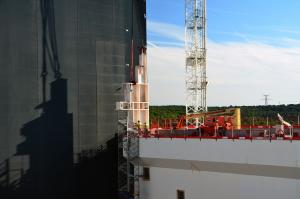First pillars for the crane hall
For the overhead cranes to deliver machine components into the Tokamak assembly pit, the rails that carry them need to be extended some 80 metres beyond the temporary wall of the Assembly Hall. The extension, part of a cladded steel structure supported by two parallel rows of ten steel pillars, will form a new volume within the Tokamak Complex — the Crane Hall where the cranes will travel back and forth as assembly work progresses inside the pit.
On Wednesday 11 September, the lower section of the first pillar was anchored into the corbel on the south side of the Tokamak Building. Although the steel piece weighs only 28 tonnes (not much by ITER standards ...) a huge crawler crane, with a lifting capacity of 650 tonnes and a boom reaching more than a hundred metres in height, was brought in to perform the operation.
By Friday, three lower pillar sections, 13 metres in height, were in place. Each lower section will be topped by a 16-metre-high upper section which, in turn, will support five pre-assembled structural modules for the roof spanning a distance of close to 50 metres. In order to lift the huge modules, a second crawler crane, positioned on the northwest side of the Tokamak Complex, will work in tandem with the one already in place.



